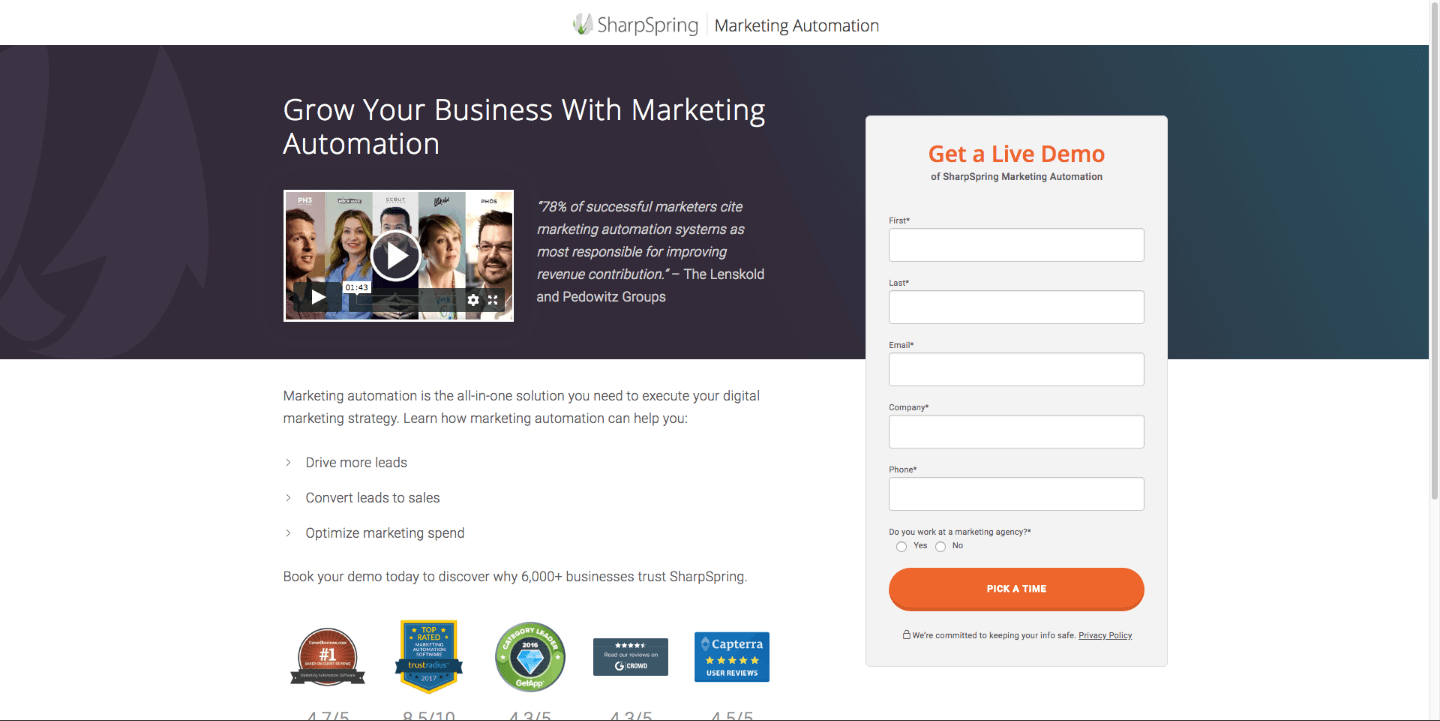
The future of SaaS marketing strategy: 3 steps to stay ahead
In an ever-changing industry, digital marketers are constantly looking for the next big tactic that will generate more sales.
Many believe the future of successful SaaS marketing strategies hinges on new ad platforms, new ad formats, machine learning, and, most recently, automated (or AI) bidding platforms. Each of these carries its unique benefits, challenges, and uses for marketers in the B2B SaaS industry.
While there’s no question that technology will continue to evolve and become more enhanced, there are a few key shifts in SaaS and B2B online marketing strategies that must take place for these upcoming innovations to truly impact revenue. Staying ahead of the curve can yield bountiful fruit for the bottom line. That means more leads, happier bosses, and more money in everyone’s pocket.
Before we spend too much time peering into the future, we must first analyze…
The current state of SaaS marketing strategy
If I had to choose a trait to lump 99% of current B2B tech marketing into, it would be Selfish.
Everywhere you turn, you see users who are:
- Looking to solve a problem.
- Served with a very relevant ad.
- Sent to a very relevant landing page.
- Asked to answer extremely irrelevant and personal questions to get what they want.
All of this is done in the same generic format, too: Show the user a little bit of content on the left side of the page; toss in a big long form on the right side of the page.
“Are you looking for information on a piece of B2B marketing software? Great, give me your name, phone, email, job title, company, tenure, age, sex, and list of hobbies. Oh, and click this checkbox to get our daily emails.”
It’s not just the little guy who’s guilty of this, either. In a search done this morning for “b2b marketing software,” I clicked on the first three advertisement links from SharpSpring, Marketo, and IBM, all of whom are using the above method of lead generation.



What’s wrong with selfish marketing? There are a few problems.
1. It screams “me, me, me”
Let’s take another look at that Marketo landing page:
Remember, my query was “b2b marketing software.” Not only do those words appear zero times on this page, but a headline confronts me to “Watch a 4-minute demo.” As a user, I begin to ask:
- A four-minute demo of what?
- Is this even marketing software?
- If so, what does it do?
I probably don’t even read the small paragraph above the form where I’m told this software covers email, nurturing, automation, and more!
More importantly, I’m not told anywhere how this product can help me. Will I save time? Better connect with my audience? Address my silent funnel? Will my team like it? Can they collaborate on it? Can anyone use it? Is programming involved? (I could keep going…).
All I can tell from this page is that Marketo is a product, and they want my information to tell me more about it. The end.
Not very helpful for an inquisitive user.
2. It lacks empathy (and value for the consumer)
The user seeking our solution or software has a pain point. That pain point likely has dozens, if not hundreds, of nuances. In today’s world, there’s almost no truth to “one size fits all” when it comes to software.
Everyone uses software a little differently because different systems need to hook in differently and operate differently internally. Instead of addressing these potential differences and asking the user about them, some marketers go straight for the “conversion.”
The thought is, “If we can get the prospect on the phone, our salespeople can handle all their questions, objections, etc.”
The reality, though, is that even a good benchmark for website conversion rate in the software industry is 7%.That means that 93% of your users do nothing and leave.
So why not give them a reason to stay?
Overcoming common sales objections is frequently talked about in the world of sales. The concept itself is simple: Know your customers’ concerns, and address how your product or service eases those concerns before the prospect ever brings them up.
It’s a strategy not unlike the one Eminem used on Papa Doc in 8 Mile, anticipating his adversary’s insults and addressing them before the guy even had a chance to go. So when it came to Doc’s turn, he had no material and forfeited.
The only problem with this being discussed at the ‘sales’ level of an organization is that we often put the entire burden of addressing objections and learning about prospects on salespeople, when the reality is that we as marketers can easily assist them.
By working with sales to understand common objections, and addressing those front and center on the landing page, you can effectively eliminate all reason for skepticism about your product or service and increase the likelihood of a conversion.
3. Users are getting smarter
Users are growing savvier by the day, and that means the time it takes them to assess a website and answer the question “will this help me” is shrinking.
A Microsoft study revealed that we now have an attention span of a mere eight seconds—that’s shorter than that of a goldfish (which clocks in at nine seconds).
In that time, we not only have to convince a user that we actually have the solution to their problem but also need to make it appear easy for them to get their solution.
Any perceived obstruction (like a form asking incredibly irrelevant questions) only increases the chances that a user will bounce, foregoing their ability to read the valuable copy on your landing page.
Where SaaS marketing strategy is headed
Ok, enough complaining about the current state of B2B online marketing trends. What can we do about it? Where are we headed?
Well, the solution part’s simple: It’s time to stop selling users and start helping them. This is an important, fundamental shift in the way that B2B SaaS marketers have been operating for the last several years.
It’s not about selling your product; it’s about asking your users how they’d like to be sold.
In this matter, B2B can take a page or two out of the B2C marketing book.
1. Allow your users to self-select
One of the most dangerous assumptions we can make as marketers is that we know exactly who the user is and what they want.
Sure, with modern analytics platforms and Lookalike audiences, we can get pretty close, but unless the user gives us more information, we can’t be 100% sure.
So why guess?
By allowing a user to tell you who they are, and taking them down a path accordingly, you’re guiding them into the thought of, “I’ve chosen all the options that are hyper-relevant to me; therefore, this suggestion/product must meet the needs I’ve selected.”
A few examples of this:
VICE Golf’s golf ball recommender
With thousands of different golf balls, it’s difficult for the average player to know precisely which ball is best for their game.
The VICE golf ball recommender asks the user six personalized and unique questions to identify the right ball for their game.
How far do you typically hit a 7-iron? Do you like more or less spin around the greens? What’s your clubhead speed? What types of golf balls do you play these days? And so on.
After answering these six quick and easy questions, the user is presented with their recommended model and a link to purchase it.
And that’s the golden ticket to securing a conversion: a recommendation based entirely on a user’s habits and preferences. Makes it hard to argue that this isn’t the best ball for them.
Window contractor’s needs assessment
We tried this approach with a client to increase the conversion rates of users trying to schedule a window replacement appointment.
This client had previously been using a “standard” landing page, much like those described earlier:

This page converted web traffic to leads at a rate of 7.49% and leads to appointments at a rate of 35%.
We then chose to adjust this form to allow users to tell us more about their situation BEFORE having to give up any personal information.
On the redesigned website, we asked questions like:
- What issues are you having with your current windows?
- How many windows are impacted?
- Where is your home (to locate the ideal technician)?

This change resulted in a web-traffic-to-lead conversion rate of 20% (a 167% increase) and a lead-to-appointment conversion rate of 51% (a 46% increase).
Not only did users happily provide more information about their situation, but the salespeople were also better able to address users’ problems immediately because they had access to this data in the CRM before the call was ever made.
2. Ask questions; don’t force answers (consultative selling)
A similar change can (and should) be made to the sales process as was made in the window landing page example.
Determine the users’ needs before determining which product (or set of features) is right for them.
The Internet has entirely changed the way that users shop for a product or service. Instead of needing to be told how a product or service can help them, users tend to do their own research and are generally well informed by the time they ever reach sales.
That means that the prospects already have perceptions of you, your product, how it can help them, and which pieces of it they believe they’ll value most.
Our landing pages should avoid being like Marketo’s: pushy, vague, and seeking info without offering value.
Instead, salespeople should strive to be like VICE golf or our window contractor friends. Ask the prospect about their pain points, what features they’re most interested in, what tangible benefit they hope to receive out of the engagement, etc. This concept is known as “consultative selling” and is heavily advocated by marketing legends like Jay Abraham.
Empower your salespeople with specific, user-identified information, and they can address the actual needs, wants, and desires of the prospect, creating better alignment with their pain points and your software’s ability to solve them.
3. Make your systems talk to each other
Answering your prospect’s questions before the sales call beats asking on the call after they’ve filled out a form.
Design your marketing technology stack around communication.
Ask relevant and engaging questions on your landing pages, feed that information to your sales team, and empower them to better address the prospect’s situation during their first conversation.
What does all this mean for the future of SaaS marketing?
Regardless of whether you’re marketing to consumers or businesses, the bottom line is that we’re all marketing to people who have problems and are seeking solutions.
Our goal as marketers is to help our audience find the best solution for their current needs. We can do that best if we:
- Focus on the user and their needs, not just our product features.
- Empathize with the users’ situation and provide value for someone in their stage of the buyer’s journey.
- Treat our users as the educated buyers they are. Cheap marketing tricks are falling by the wayside. Give users the information they seek, and then offer further assistance with a contact.
In our ever-changing landscape, it’s important to embrace the future of enterprise SaaS marketing. The best B2B marketing strategies will revolve around shifting our tactics to:
- Allow our users to self-select what they want.
- Ask questions and collect information before “selling” the prospect.
What do you think the future of SaaS marketing strategy holds? Let us know in the comments!
Read about the 8 benefits of singular negatives in Google Ads
View all posts filed under “SEO”
Most newsletters suck...
So while we technically have to call this a daily newsletter so people know what it is, it's anything but.
You won't find any 'industry standards' or 'guru best practices' here - only the real stuff that actually moves the needle.







